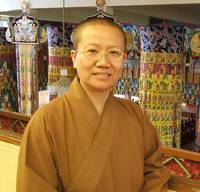Abstract: The Right to be Ordained as Bhiksunis
by Ven. Bhiksuni Chuehmen
Fo Guang Shan Buddhist Order
Tashu, Kaohsiung 840, Taiwan
When Queen Mahaprajapati told the Buddha that she was inspired to leave the householder’s life and asked his permission to lead a spiritual life in the Sangha Order, the Buddha rejected her request not only once, but three times. What was the Buddha’s motive in rejecting her and why did he give her eight conditions to uphold before ordaining her.
That was the fifth year after the Buddha’s enlightenment 2600 years ago.
Today, when Theravada nuns are requesting bhiksuni ordination, some groups within the Theravada Bhiksu Sangha object to the revival of the bhiksuni lineage. The Theravada Bhiksu Sangha argued that initially the Buddha had rejected women being ordained and since it had been interrupted, it could not be revived!
Later research revealed that the Vinaya Lineage, which the Chinese nuns received from the Sri Lankan bhiksunis in 429 CE is still alive today. So, responding to the request from their Theravada sisters, the Chinese nuns -- in gratitude for receiving the lineage from Sri Lankans -- were glad to return the lineage. But some members of the Theravada tradition also argued that the transmission from the Dharmaguptaka Vinaya is “Mahayana” and, therefore, it is not proper to revive it in the Theravada tradition. This is certainly not a very logical argument. By what right does anyone determine which nuns are to be ordained as bhiksunis, and by what authority can anyone disclaim the nuns' right to receive vows?
The basic inspiration for this paper is to point out that the Buddha recognized that women were as capable as men of attaining spiritual insights. Accordingly, they deserve to being treated equally in humanity and the nuns the right to receive the bhiksuni vows.
I do not want to go into excessive research as many scholars have already done so, what I wish to bring out is that the bhiksuni lineage from the Dharmaguptaka tradition followed the proper pravraīya (ordination procedure), and sharing the experience of my monastery, Fo Guang Shan 1 who has organized a number of ordinations 2 for monks and nuns according to the Dharmaguptaka Pratimoksa, which have been practiced by the Chinese since the Vinaya Dharma was brought to China. Here, I wish to present an account of the ordination organized by Fo Guang Shan and the record when I rallied senior monks from Theravada and Tibetan traditions to support the historic ordination of Theravada nuns in Bodhgaya in 1998.
I also wish to show the contributions of bhiksunis in the modern world, which is a fact that bhiksunis are equally capable in spiritual and social service to the world today along with their male counterparts, as the Most Venerable Tallale Dhammaloka said, “If there were to be no nuns in the Order of the Gotama Buddha, the dispensation would necessarily be an incomplete one, and there would be no use of this doctrine to the female sector of world humanity.”
I hope this paper will give those within the Theravada and Tibetan Bhiksu Sangha the wherewithal to re-establish the bhiksuni lineage vows from the Dharmaguptaka Lineage. We must all work together, as the Most Venerable K. Sri Dhammananda has said, “…to discard differences and work towards the development of the EKAYANA (one way) ideal to reach the final bliss of nirvana.”
1. The Fo Guang Shan Order was established in 1967 by Venerable Master Hsing who ordained over 1200 monks and nuns (about 80 percent are nuns) and they are now actively spreading the Buddha-dharma in nearly 200 temples around the world. The Venerable Master is instrumental in helping nuns elevate their status within the society as he believed that they had equal responsibility toward society and were equally capable of spiritual attainment. It was with this inspiration that Fo Guang Shan organized the first international full ordination for Theravada and Tibetan nuns in 1988 at the Hsi Lai Temple in Los Angeles, USA. Subsequently, another ordination for nuns of the different traditions was conducted in Bodhgaya, India in 1998, and again in Taiwan in the year 2000.
2. Fo Guang Shan first conducted higher ordinations in 1977 (Fo Guang Shan, Taiwan), subsequently in 1988 (Los Angeles), 1991 (Fo Guang Shan), 1992 (Los Angeles), 1993 (Fo Guang Shan), 1996 (Fo Guang Shan), 1998 (Bodhgaya, India) , 2000 (Fo Guang Shan) and 2004 (Wollongong, Australia)
Buddhismus (Foundation for Buddhist Studies) and
takes place in co-operation with the
Asia-Africa-Institute of the University of Hamburg.
See our list of sponsors.

